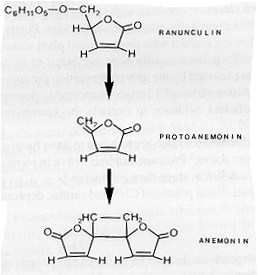Ranunculosides or Ranoculins

Protoanemonin formation
Ranunculosides or ranoculins as they are also called are volatile lactones. They are glycosides which uponhydrolysis split up into ranunculine and glucose. Ranunculine is then converted into an unsaturated lactone: protoanemonine.
Toxic Properties
Protoanemonine is a very unstable compound. Upon drying it reacts into anemonine which further converts into anemonic acid by itself. Ranunculine, protoanemonine and anemonine have medicinal properties, anemonic acid does not. Protoanemonine is toxic, its derivatives are not.
The sap of any plant of the family Ranunculaceae has a burning taste and may cause reddening of skin followed by swelling and even blistering. If swallowed in large quantities, stomach irritation may follow and further develop into stomach colic and extreme gastro-enteritis and diarrhea mixed with blood. For treatment large quantities of mucilage is required.
Safety
Ranunculosides are chemically similar to coumarins ( both are lactones) but are less stable as they are not phenolic substances.
Anyone collecting or handling plants of the family Ranunculaceae with bare hands should be careful not to holding them for long as the sap irritates the skin and can cause blisters.
Some plants containing ranunculosides:
Chrishmas rose (Helleborus niger), marsh marigold (Calatha palustris), clematis (Clematis recta), wood anemone (Anemone nemorosa), hepatica (Hepatica nobilis), field buttercup (Ranunculus acris), globe flower (Trollius europaeus,) and pasque flower (Pulsatilla vulgaris)
[Toxic Properties] [Safety] [Some plants containing ranunculosides] [Return to list of toxicants]